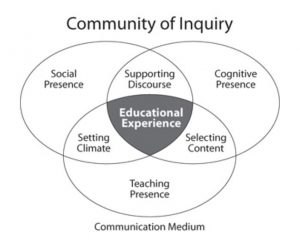Reasoning & Theory
In Chapter 4 of the Bates textbook, several design principles are laid out for successful discussion. Through my chosen forms of student/student-instructor interactions, although I may not be able implement all of them successfully, I plan to build around a couple of these design principles to start with:
Clear guidelines on student online behavior – I would like to take the opportunity in this class to build a set of class rules that can be used across any of the classes I teach. The online classroom, both synchronous and asynchronous, is largely an unexplored area for many students in Saskatchewan. I think that the experiences students have had thus far are negatively impacted by not knowing how to act within this space. Many communications are informal, riddled with spelling mistakes, and the minority of students understand the value of community building in this space.
-Regular, ongoing instructor “presence” – Regular involvement of the instructor in forum postings and small group video conferences is important to building community and having meaningful interactions. Without a focus on this area, it would be difficult to build a Community of Inquiry centered around the educational experience. I make sure to have a constant presence within my physical classroom and school, I would like to design my interactions to help me utilize this strength of mine that I already possess.

Choice, Justification, & Assessment
With these design principals in mind, I am going to use the “Discussions” feature of my chosen LMS, Canvas, along with Twitter and Zoom to expand the walls of our learning community past the LMS.
Discussions – This forum posting feature of Canvas seems to be an ungraded version of Moodle or Blackboard with several intriguing bells and whistles. This choice will allow me easily and effectively implement guidelines on student behavior and have an ongoing presence as the instructor. Students can access this method asynchronously and keep their guided conversations going throughout the week. This will be a way that I can allow students to engage in a meaningful way using content from class.
Twitter – I like the idea
of twitter for classroom interactions as it allows for students to explore beyond the course and its material. This will be helpful in creating more inquiry based learning and informal student interactions. This type of tool is a little out of my comfort zone as an instructor, which is why I believe I need to explore it within the creation of my course prototype.
Zoom – I like Zoom and video conferencing for the opportunities in can create for small group interactions between students. This is a platform where I can best implement regular, ongoing instructor presence with my students.
For forum posting within Canvas, I am going to try and utilize their quick, assessment tools for these postings. I struggle with giving timely feedback as it often takes me a long time to get through assignments, a quick, effective tool for assessment is something I desperately need in my courses. Outside of that, I will adopt guidelines for assessment that are based on participation, engagement, and community building from my students, rather than testing knowledge of course content.
I like how you organized your blog post and broke down the sections from this weeks reading. Your idea for a class twitter is interesting. I feel that there would be a lot of pre teaching that would go into that and also thinking about privacy. I look forward to hearing about how you make that work. Well done!
Scott,
Having a class Twitter account would be exciting and a great way to have students learn about appropriate online interactions, as it is authentic. Like Laurie, I think some pre-teaching would be necessary, but I’ve seen a number of teachers successfully do this!
I like that you focused on 3 main principles… One step at a time! Having clear guidelines for online interactions or a code of conduct is foundational to any online course. Like you said, students need to understand the importance of community in these spaces and need explicit instruction on how to foster this. Since most educators were thrown into remote learning, with very little knowledge themselves, it was difficult teaching these skills. Having the opportunity to build a course will allow us to be more deliberate in how we build community and set those guidelines!